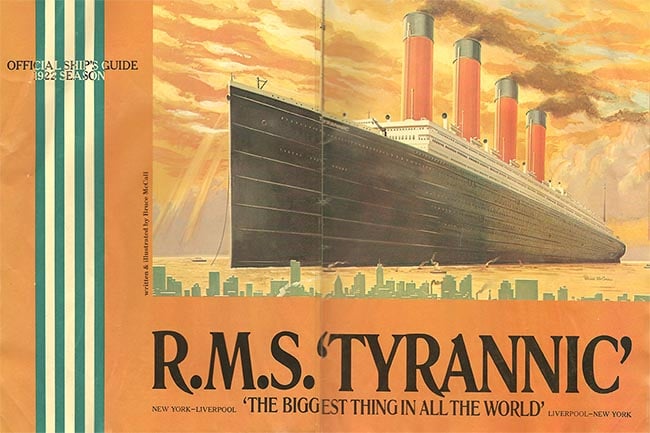Occasionally I come across something fun or amusing about cruising that isn’t about trip planning or better understanding the industry, but a voice in my head tells me it might be fun to share with readers. Actually, that voice is my father’s, and it’s coming out of my telephone, so full credit (and blame) goes to him for this post.
In the 1970s, cruising as we know it today was just becoming a reality. Ocean liners and cruise ferries had long been sailing, but in the US, the idea of leisure trips on ships was only beginning to enter the minds of Americans with the recent creation of Norwegian Caribbean Line (now Norwegian Cruise Line or simply NCL) followed by Carnival Cruise Line.
As the public saw firsthand the massive scale and opulence of passenger ships that challenged the perception of floating craft for many, this combined with the intrigue of ocean liners still steaming the Pacific and Atlantic oceans, invited satire. Few publications at this time were as popular and edgy as National Lampoon, so in their April 1974 edition, they included a “souvenir brochure” for the RMS Tyrannic.
The magazine makes amusing references to the mammoth vessel which claims the title of “The Biggest Thing in all the World”. Looking suspiciously like a squared-off and scaled-up version of Cunard's Queen Mary, the ship touts chariot races and other over-the-top amenities and superlatives for first class guests alongside greatly diminished experiences for others, including “…a deck of cards in the Steerage Tuck Shop.”
One common thread among all the jokes however, in addition to the rather stark contrast in passenger classes, is the size of the ship. This is especially fun to think about since at the time the largest passenger ships sailing were around 75k GRT – quite small compared to some of today’s megaships coming in at over 225k GRT.
Social Distancing on the RMS Tyrannic
What makes this article a bit relevant today is one of the captions. An illustration (below) shows an open deck with railings and lifeboats on one side and a few passengers strolling about, barely recognizable as people given their small size compared to the comically large ship. This effect is further emphasized as your eyes reach the edge of the opposite page, only to realize you’re only looking at the port side of the ship. The caption reads, “The right crowd, and no crowding.” Also humorous but less relevant is the remark, “The Boat Deck is reserved for First Class, with harsh penalties for interlopers.”
The line, “The right crowd, and no crowding”, in addition to frankly sounding potentially prejudice (but again, this is satire), appears to be borrowed from a 1930s slogan adopted by the Brooklands Automobile Racing Club. It also touches on a key perception of cruising that is of particular sensitivity today: crowding on ships.
Some Serious Thoughts – But Only for a Moment
If you’ve only sailed contemporary lines, you may think that crowding on cruise ships is somewhat inevitable, and to some degree (with many variables, like specific ships for one) it’s true that things like muster drills, disembarkation, and other events can pack guests a bit tightly, even where modern design really does separate folks quite well while a ship is underway.
In the upper-end of the market we see far more generous passenger:space and passenger:crew ratios. Even embarkation day on many of those sailings feels less crowded than a port-day on a contemporary ship when most guests are ashore. This however, isn’t an option for many, as the costs are higher, and quite frankly, those lines don’t offer the experiences many are looking for (high-energy activities, wild amenities such as surf-simulators, etc).
As cruse lines attempt to address COVID-19 related wellness measures, megaships have one distinct advantage over smaller contemporary ships: economy of scale. If you take a smaller contemporary cruise ship, of say, 130kGT (such as the Carnival Dream), and reduce the passenger load until social distancing can be maintained, you may find capacities reduced to the point it’s simply not practical for cruise lines to operate. Larger ships however offer more deck and pool space, and more venues in which guest activities can be spread out.
Finally, these larger ships are generally newer and inherently more economical to operate. In short, for contemporary cruise lines (Norwegian, Carnival, Royal Caribbean, MSC), running a 3,000+ passenger ship at 50% capacity may be more comfortable for guests, and financially feasible for cruise lines, than running a 1,700 passenger ship at 50%. Of course, if it’s upper-premium or luxury cruising you want, the necessary reduction in occupancy may be less extreme.
Back to Not-Reality
Really I just wanted to post this for fun. The National Lampoon piece is amusing, especially given the incredible development of larger ships and fantastical features that came decades after it was published. You can go back and click the images for full-size versions in order to more easily read the text, or try and pick-up a used copy of the April 1974 issue online.
I’d love to scan and publish the whole thing, but since I’ve not found others doing so just yet, I’d hate to find out that the fine folks at PalmStar Media find cease and desist letters as fun to send as I found this 46 year old magazine was to read.
If you really want to read the full copy, I’ll be delighted to bring it on the next cruise we get to take, buy you a drink, and review it together… perhaps six feet apart from each other as we watch the onboard chariot race.




